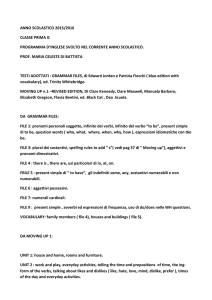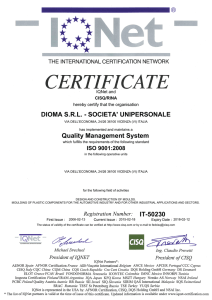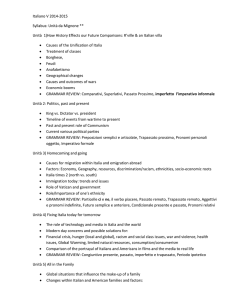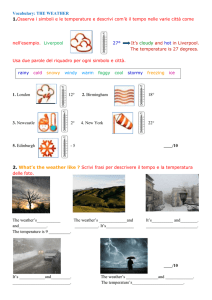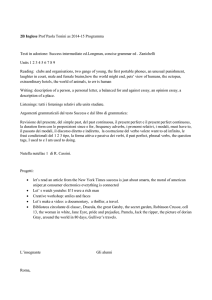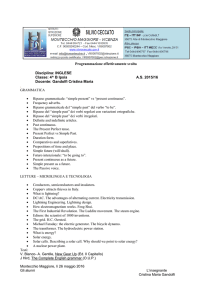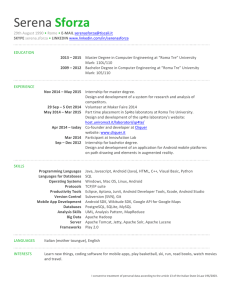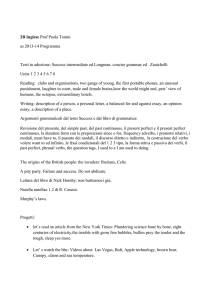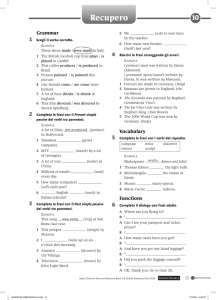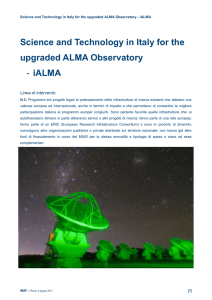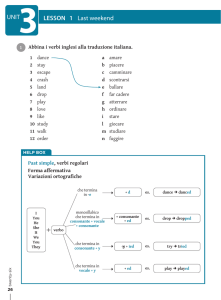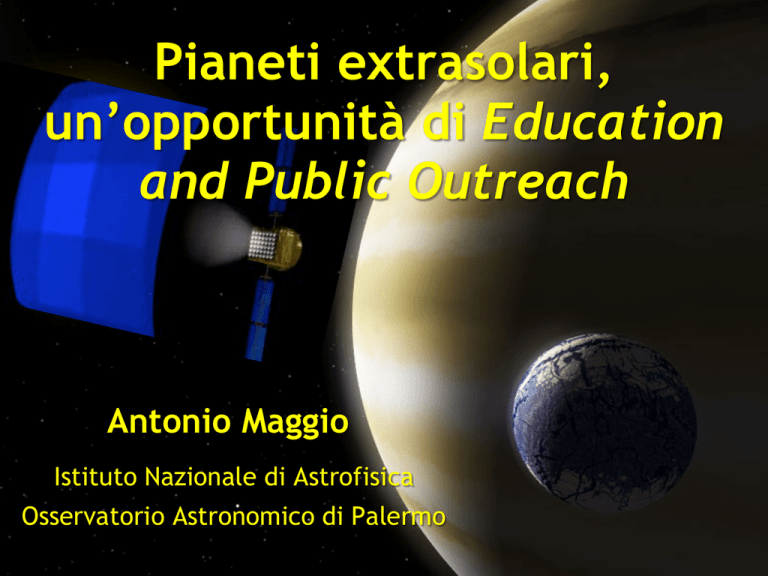
Pianeti extrasolari,
un’opportunità di Education
and Public Outreach
Antonio Maggio
Istituto Nazionale di Astrofisica
Osservatorio Astronomico di Palermo
La ricerca dei pianeti extrasolari in Italia - Roma 5-7 novembre 2014 – A. Maggio, INAF OAPa
Why so an interesting topic
• Fundamental question about our own
existence in the Universe, ancient
cultural roots
• Recent, fast growing and prolific
research field, rich of surprises
• Yet a very simple science theme, easy
to understand for anybody
• Far reaching interdisciplinary links
La ricerca dei pianeti extrasolari in Italia - Roma 5-7 novembre 2014 – A. Maggio, INAF OAPa
An amazing historic tale
∼300 B.C. – 1500 D.C.: centuries of
philosophical speculations
1500 – 1700: from heretical proposition to
scientific revolution
1850 – 1990: several decades of “false
alarm” occurrences
1992 – 1995: first real discoveries
2003 – 2009: the space mission race starts
Today: forthcoming answer to the Big
Question?
La ricerca dei pianeti extrasolari in Italia - Roma 5-7 novembre 2014 – A. Maggio, INAF OAPa
Preposterous discoveries
Wolszczan & Frail 1992: A planetary
system around the millisecond pulsar
PSR 1257+12; planet b mass = 0.02 M⊕ !
Thorsett et al. 1993: PSR B1620-26 A binary radio pulsar with a planetary
companion in the globular cluster M4
Mayor & Queloz 1995: A Jupiter-mass
companion to a solar-type star;
M sin i = 0.5 MJ, Porb = 4.2d, a = 0.05 AU!
Can you believe it?
La ricerca dei pianeti extrasolari in Italia - Roma 5-7 novembre 2014 – A. Maggio, INAF OAPa
So many “first time” observations
1999: υ And, 1st multiple-planet system (Butler
et al.); HD 209458b, 1st transiting exoplanet (D.
Charbonneau; G. Henry)
2001: 1st study of the atmospheric composition
of an exoplanet with HST; HD 28185b, 1st
planet around a Sun-like star in a long-period
circular orbit and in the Habitable Zone
2002: ι Dra b, 1st planet orbiting a giant star
2005: 1st direct observations in IR of exoplanets
with Spitzer
2007: 1st detection of water vapor in a
planetary atmosphere (Tinetti et al.); 1st
weather
map;
and
so
on…
La ricerca dei pianeti extrasolari in Italia - Roma 5-7 novembre 2014 – A. Maggio, INAF OAPa
η⊕
A new crucial quantity: Eta Earth
Current estimates: between 6 and 23 billion exoplanets in
our Galaxy
La ricerca dei pianeti extrasolari in Italia - Roma 5-7 novembre 2014 – A. Maggio, INAF OAPa
Interdisciplinary Links
Technology
Classical
and Modern
Physics
Extrasolar
planets
Math,
Statistics,
Informatics
Chemistry,
Biology
English
language
History,
Philosophy,
Epistemology
Geology, Climate,
Earth Science
La ricerca dei pianeti extrasolari in Italia - Roma 5-7 novembre 2014 – A. Maggio, INAF OAPa
Technology, on Earth
WASP, HATNet, TReS, OGLE
(robotic telescopes)
APACHE, and other INAF small
telescopes
HARPS and HARPS-N@TNG
(specialized instrumentation
vs. multi-purpose facilities)
Technology, the future
Projects with involvement of Italian scientists (just a selection)
CHEOPS
PLATO
From philosophical topic to
popular culture
From Epicurus to Galilei (philosophy, epistemology)
From Voltaire to Calvino and the modern Science
Fiction (literature)
From Fermi Paradox (‘50) & Drake’s Equation (‘60)
to the Kepler survey (probability, statistics)
From Star Trek TV series (1966) to Avatar (2009)
Exoplanets in newspapers and magazines (media)
Exoplanets in smartphone apps and toys
(merchandising)
A new «bussiness»: selling exoplanet names
Exoplanets in The New York Times
La ricerca dei pianeti extrasolari in Italia - Roma 5-7 novembre 2014 – A. Maggio, INAF OAPa
Transiting exoplanet Lego kit
La ricerca dei pianeti extrasolari in Italia - Roma 5-7 novembre 2014 – A. Maggio, INAF OAPa
Naming exoplanets: science or bussiness?
http://www.iau.org/news/pressreleases/detail/iau1406/
Exoplanets in Italy:
a joint venture in science
• Birth of a new science community, and the need for a
new window and communication channel on the Web
Special credit: I. Pagano
La ricerca dei pianeti extrasolari in Italia - Roma 5-7 novembre 2014 – A. Maggio, INAF OAPa
Exoplanets in Italy:
a joint venture in science
• The Global Architecture of Planetary
System (GAPS) project, including a Work
Package for E/PO activities
• Sinergy with the INAF national E/PO
project “Astronomia e Società” funded
by MIUR in 2013 (PI A. Maggio)
La ricerca dei pianeti extrasolari in Italia - Roma 5-7 novembre 2014 – A. Maggio, INAF OAPa
Exoplanets in Italy:
a joint venture in science
• “Second life” of Telescopio Nazionale Galileo equipped
with the HARPS-N spectrograph
http://altrimondi.tng.iac.es (special credit: S. Masiero)
La ricerca dei pianeti extrasolari in Italia - Roma 5-7 novembre 2014 – A. Maggio, INAF OAPa
Exoplanets in Italy:
a joint venture in science
• Special funding of the INAF “Way to Other Worlds”
(WOW) project, for coordination of research, higher
education and dissemination activities
Higher education
- PhD fellowships
- PhD School
E/PO
- Web site
- Resources for teachers
- Labs for children
- Multimedia
La ricerca dei pianeti extrasolari in Italia - Roma 5-7 novembre 2014 – A. Maggio, INAF OAPa
Present outcomes and goals
• Increased visibility of INAF
R&D activities
• Better understanding of
fundamental research goals from
public and private stakeholders
• Project awards and funding
• Support for an increasing
number of young students and
researchers
• Inspiring the next
generation of explorers
La ricerca dei pianeti extrasolari in Italia - Roma 5-7 novembre 2014 – A. Maggio, INAF OAPa
The Big Question: Are we Alone?
Yet we are wishful thinkers. We still want
to be able to find life. […]
But the crucial difference between us and
past advocates of plurality is that we have
information they never had. […]
The existence of billions of planets gives us
a chance to write the equation, a chance to
pin
down
the
relationship
between
habitability and actual habitation. […]
We live in a universe that allows us to get
some measure of our own significance.
Caleb Scharf
La ricerca dei pianeti extrasolari in Italia - Roma 5-7 novembre 2014 – A. Maggio, INAF OAPa

